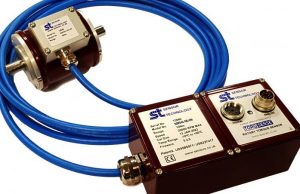
“This has two advantages,” according to the Oxfordshire company: “the sensing head can fit into very confined spaces, and the electronics can be located in a position where they are protected from physical damage, dust, dirt, moisture and electromagnetic forces.”
TorqSense SGR530 and SGR540 operate on the same four element strain gauge bridge principle as the company’s SGR510 and SGR520 ranges – introduced in 2020 as the successor to its earlier surface acoustic wave RWT type.
Shaft sizes range from 6 to 75mm and full-scales from 1Nm to 13,000Nm.
Four individual stain gauges are attached to the drive shaft, each measuring deflection in a different direction as it rotates under load. The electronics collects readings from all four gauges and calculates torque. Gauge positioning compensate for extraneous forces such as bending moments.
Signals get from the rotating shaft to the static electronics through radio frequency wireless pick-ups rather than slip-rings – a rotor mounted microcontroller, powered by through an inductive coil, measures the strain gauges and transmits digital values back through the same coil.
“Advantages include 400% mechanical overload limit, with accurate torque measurement even at these extremes, and multipoint calibration to eliminate linearity errors within the sensor,” according to the company.
Accuracy is ±0.1% and resolution ±0.01% of full scale. Power can be supplied between 12 and 32Vdc.
SGR53x and SGR54x offer different interface options amongst analogue voltage, analogue current, RS232, USB, CANbus and Ethernet.
While some versions only output torque, other deliver speed pulses (60pulse/rev) or power information. 360pulse/rev versions are planned.
The new range is designed to accurately track transient torque spikes.
“A single spike could indicate say the wrong amount of an ingredient being added to a compound or an over-sized workpiece, both of which could affect product quality,” according to company spokesman Mark Ingham. “A series of spikes would probably suggest the beginnings of a problem within the machinery, so their detection gives the plant engineers an early warning.”
Software includes TorqView and integration with LabView virtual instruments.
The SGR530 and SGR540 product page is here
